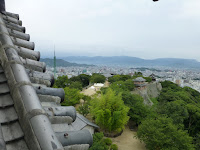Matsuyama is one of only a dozen castles in Japan which are original (built during the feudal area, before 1868). It's located high on a hill and is a bit of a challenge to reach. The ninomaru (second circle of defense) is seen in the foreground in the photo above, and today is the site of a park that preserves the layout of the former palace.
The honmaru at the top is quite complex and worth the 15-20 minute hike from the ninomaru, though there is a chairlift and cable car from the east side of the mountain.
The ninomaru has a few displays near the entrance in some buildings along the outer wall, but the original palace buildings have all disappeared.
In place of the buildings, a series of elevated levels, ponds, and gardens help show the original layout and provide a pleasant place to stroll around.
A layout of the old ninomaru can be found in one of the outer wall rooms. You can also see how difficult it would have been to get just into this second line of defense as an attacking army.
I'm always interested in the tiles found on top of roofs in Japan.
The garden is full of water spaces. The bamboo pipe plays "music" when water is poured in a certain manner.
A former basement is now a pond.
I saw a pretty interesting beetle as I left the ninomaru to head to the top. The path here is fairly well fortified at first.
For most of the hike, however, it's just uphill dirt paths and simple stairs. Eventually, you return to the fortifications as you approach the honmaru.
The castle keep at the top is very complex, with several wings making lots of nooks and crannies.
Every original castle I visit is pretty cool, but this one might be the best. If I had the money, I'd probably replicate a Japanese castle as my house!
Inside, you'll find steep stairs leading up to the top. Along the way are display cases with several artifacts.
In addition to old junk (not really junk), you can see how the building was defended. Having visited several castles, I'm a bit worn out on the "check out these holes for shooting rifles or arrows! And look at these gaps for dropping stones or hot oil!" speech.
Being at the top of a steep mountain, the view is quite expansive.
From Okaido Station on tram lines 2, 3, or 5, it's just a five minute walk to the chairlift, cable car, and eastern walking path to the honmaru and castle keep at the top. The ninomaru is at the southwest base of the mountain, and can be reached in about a five minute walk from the art museum or about 15 minutes downhill from the honmaru.
The castle keep at the top and ninomaru near the bottom are both open 9:00-17:00. Admission to the keep is 510 yen, while the ninomaru is 100 yen. If you want to use the ropeway or chair lift, the fee is 510 yen round trip or 270 yen one way.
This was my last tourist stop in Matsuyama proper, but I'd recommend to others that you begin at Bansuiso and Saka no Ue no Kumo, visit the castle keep, walk down to the ninomaru, then end the loop at the art museum. This allows you to take advantage of the chair lift or cable car to get up, and avoid backtracking. Depending on how long you spend at each location, you can expect the entire loop to fill about half a day (I started around 10:30 and finished around 1:00). From there, you can head toward Dogo Onsen, some of the other museums or attractions in Matsuyama, or spend the afternoon at Kashima Island.




























No comments:
Post a Comment